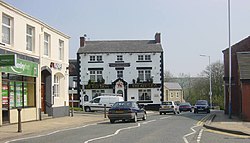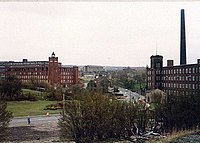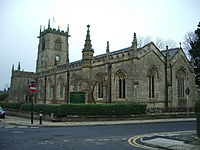Lees, Lancashire
| Lees | |
| Lancashire | |
|---|---|
 Lees village centre | |
| Location | |
| Grid reference: | SD955045 |
| Location: | 53°32’17"N, 2°4’8"W |
| Data | |
| Population: | 10,132 (2001) |
| Post town: | Oldham |
| Postcode: | OL4 |
| Dialling code: | 0161 |
| Local Government | |
| Council: | Oldham |
| Parliamentary constituency: |
Oldham East and Saddleworth |
Lees is a village in eastern Lancashire, on tthe border with Yorkshire. It lies amongst the Pennines east of the River Medlock, two miles east of Oldham. Part of Lees is known locally as 'County End' as it marks the border of Lancashire with the West Riding of Yorkshire.
Lees is believed to have obtained its name in the 14th century from John de Leghes, a retainer of the local Lord of the Manor. For centuries, Lees was a conglomeration of hamlets, ecclesiastically linked with the township of Ashton-under-Lyne. Farming was the main industry of this rural area, with locals supplementing their incomes by hand-loom weaving in the domestic system. At the beginning of the 19th century, Lees had obtained a reputation for its mineral springs; ambitions to develop a spa town were thwarted by an unplanned process of urbanisation caused by the rise of textile manufacture during the Industrial Revolution.[1][2]
Lees expanded into a mill town in the late-19th century, on the back of neighbouring Oldham's booming cotton spinning. At its height, in just half a square mile Lees had eleven cotton mills.
Geography
The village consists of a small cluster of shops and businesses on either side of the A669 Lees Road, surrounded by some terraced houses and some small estates. Lees is separated from the main conurbation of Oldham by a small amount of green belt land in the valley of Leesbrook, on either bank of the River Medlock.
At County End the town meets Springhead in Saddleworth in Yorkshire, and the two run together in one contiguous urban area.
History

The settlement dates back to the 14th century and is thought to have been named after former retainer of the manor, John de Leghes.[1][2]
Lees was one of the localities which, on 16 August 1819, sent a contingent of parishioners to the mass public demonstration at Manchester, now known as the Peterloo massacre.[3] In the week before Peterloo (an assembly demanding the reform of parliamentary representation), weavers in Lees had paraded through the village with a large black flag adorned with the slogans "no Borough Mongering, Taxation Without Representation is Unject and Tyrannical," and "Unite and be Free, Equal Representation or Death". The growing unrest in the village prompted one alarmed inhabitant to write to the Home Office.[4]
In the late-18th century, a natural chalybeate spring was discovered in the locality, and by the-early 19th century the village gained a reputation for these fashionable mineral springs.[2] In the early 19th century, water from Lees Spa, had become fashionable to drink, so much so, that it was bottled and sold around the country. In the month of August 1821, 60,000 people visited Lees Spa.[2] Ambitions to develop Lees into a spa town – "Lancashire's very own Harrogate"[2] – were thwarted by an unplanned process of urbanisation caused by introduction and profitability of textile manufacture during the Industrial Revolution.[1][2]
The Industrial Revolution brought cotton spinning to Lees in the form of eleven mills, which by the late-19th century, had changed the character of the village completely.[1]
Lees has grown in size recently in terms of both amenities and residential population, in its role as a commuter village for people working in Oldham and across in Yorkshire. It is home to commercial and distribution companies. The main street is notable for the number of public houses in close proximity.
Churches

The parish church of St Thomas the Apostle, in West Street, Leesfield was founded in 1846.[5]
The church has a Sunday School and hosts meetings of the Mothers Union, Rainbows, Brownies, Guides, Beavers and Scouts. It has an active group of bell ringers.[6] The church a seating capacity of 600 and a three manual organ. Four of the numerous stained glass windows are by the Belgian stained glass artist, Jean-Baptiste Capronnier.
- Church of England: St Thomas The Apostle
- Independent / evangelical: Christian Brethren
- Methodist: Zion Methodist Chapel.
- Roman Catholic: St Edward's
Outside links
| ("Wikimedia Commons" has material about Lees, Lancashire) |
- leesvillage.org, Lees Community Association.
- Visitoldham.co.uk, A brief history of Lees
- Information on Lees, Lancashire from GENUKI
References
- ↑ 1.0 1.1 1.2 1.3 Manchester City Council. "Oldham Towns; Lees". spinningtheweb.org.uk. http://www.spinningtheweb.org.uk/a_display.php?irn=239&QueryPage=&lang=. Retrieved 5 January 2007.
- ↑ 2.0 2.1 2.2 2.3 2.4 2.5 "The Oldham Boroughs: Lees". visitoldham.co.uk. Archived from the original on 23 May 2008. http://web.archive.org/web/20080523091037/http://www.visitoldham.co.uk/heritage/lees.htm. Retrieved 25 June 2008.
- ↑ Marlow, Joyce (1969). The Peterloo Massacre. Rapp & Whiting. p. 118. ISBN 0-85391-122-3.
- ↑ Epstein, James A. (1994). Radical Expression: Political Language, Ritual, and Symbol in England, 1790–1850. Oxford University Press. p. 75. ISBN 978-0-19-506550-3.
- ↑ "St Thomas the Apostle, Leesfield – Church of England" at genuki.org.uk
- ↑ "St Thomas Leesfield Church" at leesfieldparish.blogspot.co.uk
